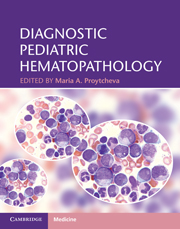Book contents
- Frontmatter
- Contents
- List of contributors
- Acknowledgements
- Introduction
- Section 1 General and non-neoplastic hematopathology
- Section 2 Neoplastic hematopathology
- 10 Chromosome abnormalities of hematologic malignancies
- 11 Expression profiling in pediatric acute leukemias
- 12 Myeloproliferative neoplasms
- 13 Myelodysplastic/myeloproliferative neoplasms
- 14 Myelodysplastic syndromes and therapy-related myeloid neoplasms
- 15 Acute myeloid leukemia and related precursor neoplasms
- 16 Hematologic abnormalities in individuals with Down syndrome
- 17 Precursor lymphoid neoplasms
- 18 Advances in prognostication and treatment of pediatric acute leukemia
- 19 The effect of chemotherapy, detection of minimal residual disease, and hematopoietic stem cell transplantation
- 20 Pediatric small blue cell tumors metastatic to the bone marrow
- 21 Pediatric mature B-cell non-Hodgkin lymphomas
- 22 Pediatric mature T-cell and NK-cell non-Hodgkin lymphomas
- 23 Hodgkin lymphoma
- 24 Immunodeficiency-associated lymphoproliferative disorders
- 25 Histiocytic proliferations in childhood
- 26 Cutaneous and subcutaneous lymphomas in children
- Index
- References
26 - Cutaneous and subcutaneous lymphomas in children
from Section 2 - Neoplastic hematopathology
Published online by Cambridge University Press: 03 May 2011
- Frontmatter
- Contents
- List of contributors
- Acknowledgements
- Introduction
- Section 1 General and non-neoplastic hematopathology
- Section 2 Neoplastic hematopathology
- 10 Chromosome abnormalities of hematologic malignancies
- 11 Expression profiling in pediatric acute leukemias
- 12 Myeloproliferative neoplasms
- 13 Myelodysplastic/myeloproliferative neoplasms
- 14 Myelodysplastic syndromes and therapy-related myeloid neoplasms
- 15 Acute myeloid leukemia and related precursor neoplasms
- 16 Hematologic abnormalities in individuals with Down syndrome
- 17 Precursor lymphoid neoplasms
- 18 Advances in prognostication and treatment of pediatric acute leukemia
- 19 The effect of chemotherapy, detection of minimal residual disease, and hematopoietic stem cell transplantation
- 20 Pediatric small blue cell tumors metastatic to the bone marrow
- 21 Pediatric mature B-cell non-Hodgkin lymphomas
- 22 Pediatric mature T-cell and NK-cell non-Hodgkin lymphomas
- 23 Hodgkin lymphoma
- 24 Immunodeficiency-associated lymphoproliferative disorders
- 25 Histiocytic proliferations in childhood
- 26 Cutaneous and subcutaneous lymphomas in children
- Index
- References
Summary
Introduction
Classification of cutaneous lymphomas
The skin is the second most common site of extranodal lymphoma after the gastrointestinal tract [1]. The term primary cutaneous lymphoma refers to cutaneous lymphomas that present in the skin with no evidence of extracutaneous disease at the time of diagnosis [2].
This chapter adopts the 2005 WHO/EORTC classification (Table 26.1) for cutaneous lymphomas [2, 3]. Prior to its publication, the two classification schemes most widely used were the 2001 World Health Organization (WHO) classification [4] and the 1997 European Organization for the Research and Treatment of Cancer (EORTC) classification [5].
The 2005 WHO/EORTC classification is a consensus system based on the premise that primary cutaneous lymphomas often have a completely different clinical behavior and prognosis from histologically similar nodal lymphomas: therefore, they require different management strategies and treatment. This new classification is validated by clinical follow-up data on 1905 patients from the Dutch and Austrian registries for primary cutaneous lymphomas [6].
Epidemiology in the pediatric age group
Primary cutaneous lymphomas are extremely rare, with an incidence of approximately 0.36 per 100 000 [7] persons per year. Cutaneous T-cell lymphomas (CTCLs) account for approximately 75% of all cutaneous lymphomas in Europe [5] and >90% in North America. Although typically considered a disease of adulthood (approximately 75% of patients are diagnosed after 50 years of age [8]), pediatric cases make up from 4 to 11% of CTCL cases, and many adult patients report initial onset in childhood [8–10].
- Type
- Chapter
- Information
- Diagnostic Pediatric Hematopathology , pp. 540 - 561Publisher: Cambridge University PressPrint publication year: 2011



